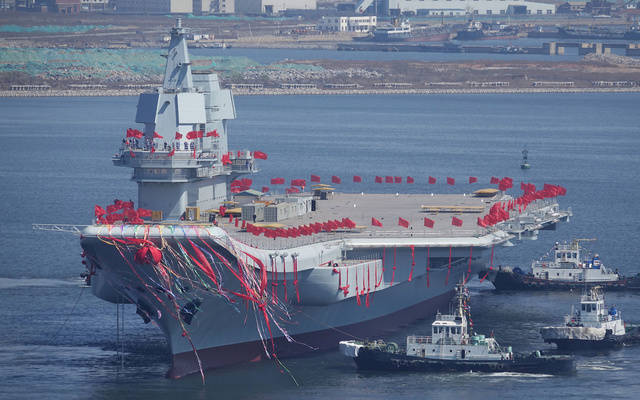
China's third aircraft carrier in the making, to project aero-sea power

The Indian Navy cannot ignore the latest development in the Chinese Peoples’ Liberation Army Navy (PLAN) – construction of a third aircraft carrier Type 002 at the Jiangnan shipyard, Shanghai. The PLAN’s second aircraft carrier the Type 001A is a domestically built vessel and presently undergoing sea trials. The third carrier when operational would further enable China to project aero-naval power far away from its shores and operate much like the US Navy across the seven oceans. From an Indo-centric security perspective this techno-military development which will introduce an additional floating weapon platform realigns the regional strategic environment.
India was the only Asian navy to possess an aircraft carrier in the post Second World War period and China became the second one to do so in 2012 with the Liaoning — a former Soviet vessel. Today the Liaoning is used as a training carrier, to establish training, techniques, and procedures for Chinese sailors in naval aviation. Importantly, the carrier has sailed thrice through the Taiwan Strait; besides visiting Hong Kong that suggests the carrier is capable of showing the flag for political signaling to other countries.
While the PLAN’s existing two carriers are equipped with a ski jump ramp which allows aircraft to take off without any mechanical assistance, the Type 002 is expected to have a more-advanced catapult launch system. It can launch more aircraft and heavier aircraft, which effectively enhances the warship’s combat capabilities as a “force multiplier” in a potential war like situation or for coercive diplomacy.
The second carrier, the Type 001A resembles the Liaoning but with few improvements, which include an active electronically scanned array (AESA) radar and a larger flight deck. The Type 001A can accommodate 30 fighter aircraft J-15 — more than the Liaoning. The Type 001A will be the PLAN’s first combat-capable carrier — although the lack of a catapult means its aircraft must sacrifice range and striking power — in order to take off from its flight deck.
China since the 1930s, during its Civil War years has been the target of aircraft carriers but never owned one herself. The Imperial Japanese Navy’s carriers conducted strikes on the Chinese mainland in support of ground campaigns in the second Sino-Japanese war. Also US aero-naval power protected nationalist Chinese forces towards the end of the Chinese Civil War. Similarly, the US Navy carriers conducted airstrikes on Chinese “volunteers” during the 1953 Korean War.
In 1996 during the Third Taiwan Straits Crisis, China fired missiles in the waters around Taiwan as the island nation prepared for its first presidential election. The United States intervened and deployed a carrier battle group near Taiwan as a sign of support against Chinese military actions. The Chinese missile flexing stopped and Taiwan conducted the election. Clearly these aircraft carriers or “floating islands” made a strategic impression on China.
The last US carrier to sail through the Taiwan Strait was the USS Kitty Hawk. Its battle group sailed there in late 2007 after being denied a port visit to Hong Kong. Lately the US has avoided sailing carriers to the Yellow Sea between the Korean Peninsula and the Chinese mainland. The US, however, continues to sail aircraft carriers through the South China Sea where many nations have claims over the waters.
In December 2008 the PLAN made its debut in international waters with the anti-piracy operations in the Gulf of Aden. The next notable naval development was the establishment of a PLAN base at Djibouti in August 2017 which is strategically located at the southern entrance to the Red Sea and the Gulf of Aden. Djibouti is only about 20 miles from war-ravaged Yemen. It lies on the Bab el-Mandeb Strait, a gateway to the Suez Canal.
The Djibouti base is an indication of China’s global ambitions. Professor Dutton of the US Naval War College, Rhode Island states, “Its naval power expansion is for protecting commerce and China’s regional interests in the Horn of Africa”. Chinese oil exports sail through the Mandeb Strait, which is a major choke point as it connects the Indian Ocean and the Mediterranean Sea. Most of China’s $1 billion in trade to Europe traverses the Gulf of Aden and the Suez Canal. Therefore, Chinese submarines, naval vessels and aircraft are visible across oceans around the globe.
For India, Djibouti’s location on the north western edge of the Indian ocean poses major challenges. For the past couple of years, the Indian Navy has reported the presence of PLAN warships, submarines and intelligence-gathering vessels in the Indian Ocean waters. Now with a base in Djibouti, Beijing will find it much simpler to sustain PLAN operations in the region. The PLAN which suffered from the tyranny of distance to operate in the Indian Ocean waters, will now be able to sail with ease, thanks to this overseas naval base.
The Indian Navy officer posted since July 2014 at the Indian Embassy, Beijing will be able to assess the PLAN better in terms of capabilities and intentions. Besides, inputs from other friendly countries like Taiwan and Japan would prove useful to corroborate PLAN related developments. Since 2014, China has launched more submarines, warships, principal amphibious vessels and auxiliaries than the total number of warships currently with the navies of Germany, India, Spain, Taiwan and the United Kingdom, according to a 2018 International Institute of Strategic Studies, London report.
Clearly the PLAN has become a more balanced fleet, capable of naval operations within the immediate near-seas and in distant waters such as the Indian Ocean and the Western Pacific open waters. To fathom the PLAN’s capabilities is not the challenge — but to figure out Beijing’s political intentions on how to use this potent maritime military instrument when and where remains problematic for the Indian military and intelligence establishment.
(The writer is a Professor of International Relations and Strategic Studies at Christ Deemed to be University, Bengaluru)


